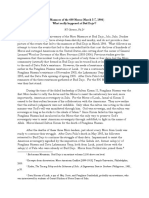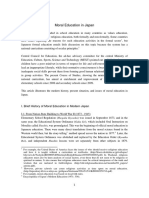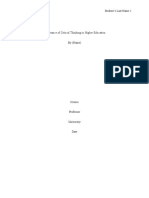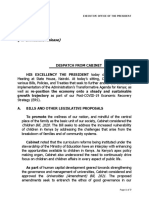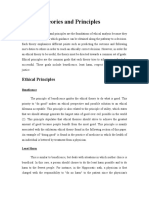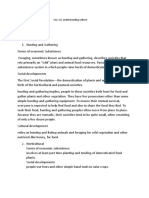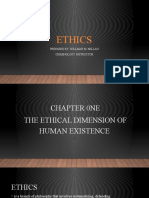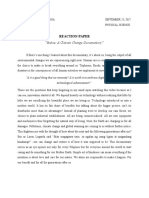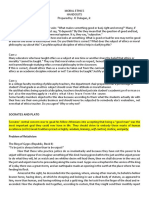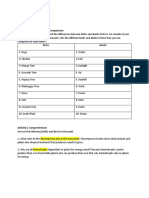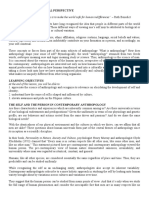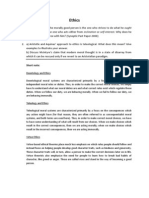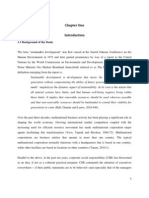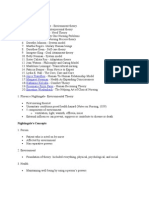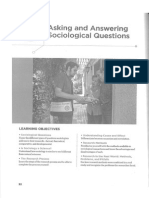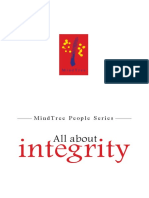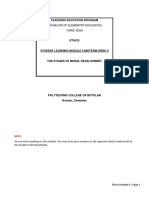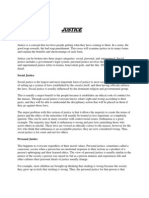Animal Ethics Chapter 1
Animal Ethics Chapter 1
Uploaded by
JeronimoEzqCopyright:
Available Formats
Animal Ethics Chapter 1
Animal Ethics Chapter 1
Uploaded by
JeronimoEzqOriginal Description:
Copyright
Available Formats
Share this document
Did you find this document useful?
Is this content inappropriate?
Copyright:
Available Formats
Animal Ethics Chapter 1
Animal Ethics Chapter 1
Uploaded by
JeronimoEzqCopyright:
Available Formats
university of copenhagen
Kbenhavns Universitet
Animal ethics
Palmer, Clare; Sande, Peter
Published in:
Animal welfare
Publication date:
2011
Document Version
Peer reviewed version
Citation for published version (APA):
Palmer, C., & Sande, P. (2011). Animal ethics. In M. C. Appleby, J. A. Mench, I. A. S. Olsson, & B. O. Hughes
(Eds.), Animal welfare. (2. ed., pp. 1-12). Chapter 1.CABI Publishing.
Download date: 29. nov.. 2015
Danish Centre for Bioethics and Risk Assessment
This is a post-print version of a chapter in
nd
Animal Welfare. 2 edition by CABI
For more articles on animal ethics, see www.animalethics.net
Chapter 1: Animal Ethics
Clare Palmer (Texas A&M University, USA), Peter Sande (University of Copenhagen, Denmark)
Abstract
This chapter describes and discusses different views concerning our duties towards animals. First, we explain
why it is necessary to engage in thinking about animal ethics and why it is not enough to rely on feelings
alone. Secondly, we present and discuss five different kinds of views about the nature of our duties to
animals. They are: contractarianism, utilitarianism, the animal rights view, contextual views, and a respect
for nature view. Finally, we briefly consider whether it is possible to combine elements from the presented
views, and how to make up ones mind.
1. Introduction: The need to give reasons for ones ethical views
This chapter describes and discusses different views on right and wrong in our dealings with
animals. What might be right or wrong is not a factual question, and therefore cannot be settled by
the same methods as those used in biology and other natural sciences. Some readers of this chapter
may even wonder whether moral issues can be settled at all; rather they may be seen as matters
purely of feeling or taste. Well suggest below that this position is problematic.
The primary focus of this book is to discuss factual issues relating to the way animals are used and
treated by humans. Until recently ethics was seen as something that should be kept at arms length
from the fact-oriented science based study of animal welfare: only once the facts are established
would it be appropriate to discuss, from an ethical perspective, where to draw the line between what
is acceptable and what is not.
But the link between factual knowledge and sound ethical judgement is not that simple - often the
study of the facts relies on tacit ethical judgements. For example, studying the consequences for
animal welfare of various ways of housing farm animals proceeds on the assumption that it is
1
The reference of the printed version is:
C. Palmer & P. Sande (2011): Chapter 1: Animal ethics. Animal Welfare. 2nd edition. M. C. Appleby, J. A. Mench, I.
A. S. Olsson & B. O. Hughes (Eds.)
The definitive version is available at
http://bookshop.cabi.org/?site=191&page=2633&pid=2233
Danish Centre for Bioethics and Risk Assessment
This is a post-print version of a chapter in
nd
Animal Welfare. 2 edition by CABI
For more articles on animal ethics, see www.animalethics.net
acceptable to use animals for food production as long as the animals do not suffer from bad welfare.
And assessments of animal welfare rely on assumptions regarding what matters, ethically speaking,
in our dealings with animals. Is it to avoid pain and other forms of suffering? Is it to give pleasure
and other positive emotion? Or to allow animals to live natural lives? To be able to deal with such
questions and to justify the tacit judgments underlying studies of animal welfare we need not only
to know the facts but to engage with and be proficient in ethical thinking.
This chapter focuses on possible answers to basic ethical questions about animal ethics: Do animals
have moral standing in their own right? And if so, what kind of duties do we have towards them?
Does it matter whether animals are wild or domesticated? Do we only have obligations to individual
animals or also to species or populations of animals? How should we balance our duties to animals
against other kinds of duties? We do not attempt to answer these questions. Rather, we take a
pluralist approach to animal ethics, presenting five diverse ethical positions, each with its own
answers. We do not side with any of these views, but we encourage the reader to consider their
strong points and why people have been drawn to them. Although we (as authors of this chapter)
have our own views, we have tried to present the arguments in a balanced way (though we may not
have always succeeded in concealing our sympathies).
However, we do take the view that its important to adopt a reasoned approach to animal ethics,
rather than one based on feelings alone. Reliance on feelings makes for difficulty in entering ethical
debates, and in explaining to others why particular attitudes or practices are either problematic or
beneficial. And for animal professionals to be taken seriously by people who hold different views,
they must show that they can comprehend the nature of disagreements about animal ethics. This
entails understanding why people make the moral judgments they do.
But what are moral judgements? They do not seem to be just statements of personal taste. The
philosopher James Rachels (1993, p.10) suggests:
If someone says I like coffee, he does not need to have a reason - he is merely making a
statement about himself, and nothing more. There is no such thing as rationally defending
ones like or dislike of coffee, and so there is no arguing about it. So long as he is accurately
reporting his tastes, what he says must be true. Moreover, there is no implication that anyone
should feel the same way; if everyone else in the world hates coffee, it doesnt matter. On the
Danish Centre for Bioethics and Risk Assessment
This is a post-print version of a chapter in
nd
Animal Welfare. 2 edition by CABI
For more articles on animal ethics, see www.animalethics.net
other hand, if someone says that something is morally wrong, he does need reasons, and if his
reasons are sound, other people must acknowledge their force.
Here, Rachels points out the importance of being able to give reasons to justify our ethical views. A
consequence of the requirement to give reasons is a requirement of consistency: If something
provides a moral reason in one case it should also count as a reason in other, similar cases. We can
see this process of reasoning by appeal to consistency in the following famous passage, first
published in 1789 (pp. 25-6), where Jeremy Bentham argues that animals ought to be protected by
the law:
The day may come, when the rest of the animal creation may acquire those rights which never
could have been withholden from them but by the hand of tyranny. The French have already
discovered that the blackness of the skin is no reason why a human being should be
abandoned without redress to the caprice of a tormentor. It may come one day to be
recognized, that the number of the legs, the villosity of the skin, or the termination of the os
sacrum, are reasons equally insufficient for abandoning a sensitive being to the same fate.
What else is it that should trace the insuperable line? Is it the faculty of reason, or, perhaps,
the faculty of discourse? But a full-grown horse or dog is beyond comparison a more rational,
as well as a more conversible animal, than an infant of a day, or a week, or even a month, old.
But suppose the case were otherwise what would it avail? The question is not, Can they
reason? nor, Can they talk? but, Can they suffer?
Bentham asks the reader to consider on what grounds legal rights (for instance, legal protection
against torture) are assigned to people. We now accept that factors such as skin colour are irrelevant
to the possession of basic legal rights. But what, then, is the relevant factor? One possible answer,
Bentham suggests, is the ability to reason and to use language. So, it might be suggested that reason
and language provide a basis for separating humans and animals, and for assigning legal rights to
humans, and not to animals. But Bentham raises a number of questions about this kind of response.
First: why think that reason and language are relevant to the generation of legal rights (any more
than, say, skin colour)? Second: some animals do appear to have reasoning abilities. And third:
Some animals are at least as reasonable as some people as human infants, or those who have
severe mental disabilities so reason and language do not obviously provide the suggested firm
dividing line between all people and all animals.
Danish Centre for Bioethics and Risk Assessment
This is a post-print version of a chapter in
nd
Animal Welfare. 2 edition by CABI
For more articles on animal ethics, see www.animalethics.net
Bentham makes us consider whether it is possible to argue consistently that all humans should be
treated in one way, and all animals in another. The first of the five views presented below maintains
that we can, indeed, consistently distinguish morally between animals and humans.
2. Five views about humanitys duties to animals
Moral philosophers distinguish a number of types of ethical theory, and in principle any of these
might underlie a persons views about the acceptable use of animals. Here five prominent
theoretical positions will be presented: contractarianism, utilitarianism, an animal rights view,
contextual views, and a respect for nature view. These have direct implications for the ongoing
debate over animal use.
2.1 Contractarianism
Why be moral? This is a central question in moral philosophy, and one to which the contractarian
gives a straightforward answer: you should be moral because it is in your self-interest. Showing
consideration to others is really for your own sake. Moral rules are conventions that best serve the
self-interest of all members of the society.
Contractarian morality as here defined (the term may also be used of other views that we dont
discuss here) applies only to individuals who can contract in to the moral community, so it is
important to define who these members are. The philosopher Narveson puts this as follows:
On the contract view of morality, morality is a sort of agreement among rational,
independent, self-interested persons, persons who have something to gain from entering
into such an agreement []
A major feature of this view of morality is that it explains why we have it and who is party
to it. We have it for reasons of long-term self-interest, and parties to it include all and only
those who have both of the following characteristics: 1) they stand to gain by subscribing
to it, at least in the long run, compared with not doing so, and 2) they are capable of
entering into (and keeping) an agreement. [] Given these requirements, it will be clear
why animals do not have rights. For there are evident shortcomings on both scores. On the
Danish Centre for Bioethics and Risk Assessment
This is a post-print version of a chapter in
nd
Animal Welfare. 2 edition by CABI
For more articles on animal ethics, see www.animalethics.net
one hand, humans have nothing generally to gain by voluntarily refraining from (for
instance) killing animals or treating them as mere means. And on the other, animals
cannot generally make agreements with us anyway, even if we wanted to have them do
so
(Narveson 1983, p.56)
So, on this view, people are dependent on the respect and cooperation of other people. If
someone treats fellow humans badly, he or she will be treated badly in return. In contrast, the
animal community will not strike back if, for example, some of its members are used in painful
experiments. So, a person needs only to treat animals well enough for them to be fit for his or her
own purposes.
As non-human animals cannot enter into a contract, or agreement, governing future conduct, they
cannot, according to the contractarian view, join the moral community. On this view, any kind of
animal use may be desirable inasmuch as it brings human benefits, such as income, desirable food,
and new medical treatments.
That animals are not members of the moral community does not necessarily mean that their
treatment is irrelevant from the contractarian perspective: if people like animals, for example,
animal use can become important, since it is in a persons interests to get what he or she likes. But
the contractarian view of animals is human-centred; any protection animals have will always
depend on, and be secondary to, human concerns. A further implication is that on this view, it
would be likely that levels of protection would differ across animal species. Since most people like
cats and dogs more than rats and mice, causing distress to cats and dogs is likely to turn out to be
a more serious problem than causing the same amount of distress to rats and mice.
This contractarian view accords with attitudes to animal treatment that are common in many
societies. But it raises many problems. Is causing animals to suffer for a trivial reason really morally
unproblematic, if no human being cares? After all, some humans small children, for instance also cant behave in reciprocal ways, or make contracts with other people. Would it be morally
acceptable to eat or experiment on them, if other human contractors didnt object? Many people
consider that its immoral as such to cause another to suffer for little or no reason, whether ones
victim is a human being or an animal. An ethical theory that captures this view is utilitarianism.
Danish Centre for Bioethics and Risk Assessment
This is a post-print version of a chapter in
nd
Animal Welfare. 2 edition by CABI
For more articles on animal ethics, see www.animalethics.net
2.2 Utilitarianism
Utilitarian ethical theory provides probably the most well-known approach to animal ethics.
Utilitarianism is consequentialist in form: that is, only consequences are important when making
ethical decisions, and we should always aim at bringing about the best possible consequences. But
what counts as the best possible consequences? Here, forms of utilitarianism diverge. One leading
form promoted by Jeremy Bentham maintains that consequences should be measured in terms
of maximizing pleasures and minimizing pains. If animals feel pain and pleasure, then they should
be included in our calculations about what to do. Indeed, on this view, theres no reason to privilege
human pain over animal pain. Pain is pain, wherever it occurs. So a certain kind of equality is very
important: the pains of every being should be taken equally into account, whatever the species of
the being concerned.
In recent animal ethics, this view has been most forcefully defended by the philosopher Peter Singer
(1989, pp 152). Singer uses the language of interests in outlining his position: if a being can suffer,
it has an interest in avoiding suffering, and its interests should be treated equally to the similar
interests of other beings, whether they are human or not:
I am urging that we extend to other species the basic principle of equality that most of us
recognize should be extended to all members of our own species. ...Jeremy Bentham
incorporated the essential basis of moral equality into his utilitarian system of ethics in the
formula: Each to count for one and none for more than one. In other words, the interests of
every being affected by an action are to be taken into account and given the same weight as
the like interests of any other being. The racist violates the principle of equality by giving
greater weight to the interests of members of his own race, when there is a clash between their
interests and the interests of those of another race. Similarly the speciesist allows the interests
of his own species to override the greater interests of members of other species. The pattern is
the same in each case.
For the utilitarian, what matters are the interests of those affected by our actions- not the race or the
species of the beings who have the interests. The strongest interests should prevail no matter who
has them. This view can have radical consequences. Take modern intensive livestock production.
Broiler chickens and animals in confined feeding operations often suffer. Some basic interests of
Danish Centre for Bioethics and Risk Assessment
This is a post-print version of a chapter in
nd
Animal Welfare. 2 edition by CABI
For more articles on animal ethics, see www.animalethics.net
these animals are set aside so that production is efficient and meat is cheap. But for affluent
individuals cheap meat is not a basic interest; in a country such as Denmark ordinary consumers
only spend around 10 % of their disposable income on food. If such consumers paid 30% or 50%
more, and the extra money was used to improve the living conditions of the animals, this would
mean an immense increase in welfare and a substantial reduction in suffering, without significantly
decreasing human welfare. Therefore, according to the utilitarian view, we ought to make radical
changes in the treatment of intensively farmed animals.
Indeed, Singer (1979, p.152) argues that we should become vegetarians, because consumption of
meat and other products from commercially reared animals creates animal suffering that isnt
outweighed by the human pleasure it generates. (There are also other utilitarian arguments in favour
of reducing meat consumption based on the negative consequences for sentient beings from the
effects of meat production on the environment, on climate and on resource use.)
However, utilitarianism does not endorse a principle that killing animals is wrong. Killing is
certainly likely to be morally problematic for two reasons: it may cause suffering, and once a being
is killed, it can no longer have positive experiences. So, killing may both increase suffering and
reduce pleasure in the world. But it need not. As Singer says: It is not wrong to rear and kill it [an
animal] for food, provided that it lives a pleasant life, and after being killed will be replaced by
another animal which will lead a similarly pleasant life and would not have existed if the first
animal had not been killed. This means that vegetarianism is not obligatory for those who can
obtain meat from animals that they know to have been reared in this manner.(Singer 1979:, p.153)
This utilitarian view on killing animals may give rise to worries which are animated by Michael
Lockwoods (1979: 168) troublesome (fictional) case, Disposapup:
Many families, especially ones with young children, find that dogs are an asset when they are
still playful puppies,but become an increasing liability as they grow into middle age, with
an adult appetite but sans youthful allure. Moreover, there is always a problem of what to do
with the animal when they go on holiday. It is often inconvenient or even impossible to take
the dog with them, whereas friends tend to resent the imposition, and kennels are expensive
and unreliable. Let us suppose that, inspired by Singers article, people were to hit on the idea
of having their pets painlessly put down at the start of each holiday (as some pet owners
already do), acquiring new ones upon their return. Suppose, indeed, that a company grows up,
Disposapup Ltd, which rears the animals, house-trains them, supplies them to any willing
Danish Centre for Bioethics and Risk Assessment
This is a post-print version of a chapter in
nd
Animal Welfare. 2 edition by CABI
For more articles on animal ethics, see www.animalethics.net
purchaser, takes them back, exterminates them and supplies replacements, on demand. It is
clear, is it not, that there can, for Singer, be absolutely nothing directly wrong with such a
practice. Every puppy has, we may assume, an extremely happy, albeit brief, life - and indeed,
would not have existed at all but for the practice.
Some people may, after thinking a bit, accept that it is in principle acceptable to replace dogs in this
way. However, they will then have to face a further, related problem: the apparent implication that
we can painlessly kill humans, if we create new humans to replace them! This difficulty has led
some utilitarians including Singer himself to make a further distinction, based on the possession
of self-consciousness. Although its difficult to define self-consciousness, some utilitarians have
maintained that a self-conscious being is one that has a preference or a desire to go on living, and
that the frustration of such basic desires is morally relevant. They argue that (either in addition to,
or instead of) minimizing pain, we should minimize the frustration of desires in the world,
especially the frustration of that most basic desire of a self-conscious creature - the desire to go on
living.
However, this does not really seem to solve the problem. For it sounds as though, in principle, it
would be morally permissible to painlessly kill a self-conscious human if the human were replaced
by another human who lives a better life than the first (to make up for the loss incurred by the
killing) and who would not otherwise have existed. Admittedly, the utilitarian may argue that
killing humans and animals has very different consequences. Killing humans usually has negative
emotional and social effects on survivors in a way that killing animals doesnt. However, to say that
the wrong in painlessly killing humans lies in effects on other people may reasonably be regarded as
missing the point.
Singer himself, in his book Practical Ethics, argues that the creation of a new desire to live cannot
be weighed against the frustration of someone elses desire to go on living that is, that preferences
are not substitutable in this way. However, this starts to move away from some of the fundamental
calculative elements of utilitarianism, since it suggests that there are some goods (such as a desire to
go on living) that just cant be compensated for by the creation of more of the same goods (more
desires to live). In fact, this kind of view that some harms are just unacceptable, whatever the
ensuing benefits is much more closely associated with a different approach to animal ethics: a
rights view.
Danish Centre for Bioethics and Risk Assessment
This is a post-print version of a chapter in
nd
Animal Welfare. 2 edition by CABI
For more articles on animal ethics, see www.animalethics.net
2.3 The animal rights view
We can think about rights in two senses: legal and moral. Legal rights are rights that are created and
that exist within legal systems. Moral rights, though, are not created by the law; those who argue
from a moral rights-based perspective give a variety of different accounts of the origin of rights.
One traditional - though now controversial - claim depends on the intuition that humans naturally
have rights; to be a rights-holder is just part of what it is to be human.
Claims about rights are particularly important here for two reasons. First is the special force that
rights language carries. Although the term rights is sometimes loosely used just to mean having
moral status (its in this loose sense that Singer is sometimes called the father of animal rights)
philosophers generally understand rights in a more restricted sense. In this restricted sense, to say
that a being has moral rights is to make a very strong claim that those rights should be protected or
promoted. Indeed, sometimes possessing a right is described as having a trump card the kind of
claim that wins out over any competing claims. Second is the fact that some philosophers have
extended the idea of moral rights beyond humans, arguing that animals also have moral rights. After
all, such philosophers argue, its not just being biologically human a member of the species Homo
sapiens that gives a being rights. Rather, it must be the possession of particular capacities (such as
sentience or self-awareness) that one has as a species-member that underpins humans rights. But if
its capacities, not genes, on which rights possession is based, then perhaps some animals share the
relevant basic capacities, and should be thought of as having rights? Its this view thats adopted by
animal rights advocates, most prominently the philosopher Tom Regan in The Case for Animal
Rights (1984).
Regan (2007, p.209) argues that all experiencing subjects of a life should be thought of as
possessing moral rights. An experiencing subject of a life is a conscious creature having an
individual welfare that has importance to it whatever its usefulness to others. Such beings want
and prefer things, believe and feel things, recall and expect things. They can undergo pleasure and
pain, experience satisfaction and frustration, and have a sense of themselves as beings that persist
over time. Such beings have, on his account, inherent value of their own, based on their nature and
capacities. They are not instruments for someone elses use and benefit. Inherent value, Regan
maintains, cant be traded off, factored into calculations about consequences, or replaced. Creatures
that possess it and Regan argues that all mentally normal adult mammals fall into this category
have basic moral rights, including the right to life and to liberty. The evidence that infant mammals,
Danish Centre for Bioethics and Risk Assessment
This is a post-print version of a chapter in
nd
Animal Welfare. 2 edition by CABI
For more articles on animal ethics, see www.animalethics.net
birds, fish, reptiles and some invertebrates are experiencing subjects of a life is less clear. However,
since we cannot be sure about their inner worlds, Regan (184 p.416) argues that we should give
them the benefit of the doubt in moral decision-making, since they too may have inherent value.
Regan explicitly sets up his rights view in opposition to utilitarianism. Utilitarians, he maintains, are
fundamentally mistaken in thinking that harming some beings to bring about good consequences for
others is morally acceptable. On the contrary: That would be to sanction the disrespectful
treatment of the individual in the name of the social good, something the rights view will not categorically will not - ever allow. So utilitarian and rights views will, in some cases, diverge in
practice and they will always diverge in principle. Regan, for instance, comments on animal
experimentation and commercial animal agriculture:
The rights view is categorically abolitionist. Lab animals are not our tasters; we are not their
kings. Because these animals are treated routinely, systematically as if their value were
reducible to their usefulness to others, they are routinely, systematically treated with lack of
respect, and thus are their rights routinely, systematically violated.As for commercial animal
agriculture, the rights view takes a similar abolitionist position. The fundamental moral wrong
here is not that animals are kept in stressful close confinement or in isolation, or that their pain
and suffering, their needs and preferences are ignored or discounted. All these are wrong, of
course, but they are not the fundamental wrong. They are symptoms and effects of the deeper,
systematic wrong that allows these animals to be viewed and treated as lacking independent
value, as resources for us - as, indeed, a renewable resource. (Regan 2007, p.210)
Of course, sometimes the judgments of a utilitarian and a rights theorist about particular cases of
experimentation or commercial animal agriculture will coincide: some animal experimentation, and
most commercial animal agriculture as currently practised, should consistently be condemned by
both. But the underlying reasons for these judgments differ. A utilitarian is primarily concerned
about suffering or desire-frustration in cases where the benefits derived do not seem to outweigh the
costs. In contrast, a rights theorist is concerned about failing to respect animals inherent value, and
violating animals rights, irrespective of potential good consequences. From the rights perspective,
the utilitarian idea that the interest of an animal in continuing to live may be outweighed by
conflicting interests, i.e. the combined interests of the future animal which will replace it and human
interests in animal production, is morally abhorrent. So a rights view is abolitionist, whereas in
Danish Centre for Bioethics and Risk Assessment
This is a post-print version of a chapter in
nd
Animal Welfare. 2 edition by CABI
For more articles on animal ethics, see www.animalethics.net
contrast a utilitarian will ask questions about the benefits of any particular practice involving
suffering to animals before coming to a view about its moral permissibility.
On Regans rights view, killing even where it is painless and another being is created harms the
being that is killed. Regan (1984, p.99) describes killing as harm by deprivation an animal that is
killed is deprived of all the goods that the rest of its life would otherwise have contained, even if its
death is sudden and unanticipated. Indeed, to kill an experiencing subject of a life is to display
ultimate disrespect, by destroying the animals inherent value, and thus violating its rights.
An animal rights view such as Regans though providing a plausible alternative to utilitarianism
generates its own difficulties. One problem concerns how to handle rights conflicts. For example, it
may be difficult to combine respect for the rights of all rodents with the aim of securing human
health and welfare. If these pests are not controlled they may pose a threat because they eat our
food, and because they spread disease. It seems to be either them or us. What has the rights view to
say about this?
Regan certainly thinks that we are entitled to self-defence. If I am attacked by a bear, for instance, I
may kill the bear since this is a case of my life, or the bears. And, he might suggest, there are
probably ways of avoiding conflict over food and disease, by more systematically and efficiently
separating rodents from our food supplies. But still, its possible that if human lives really were at
stake from threats presented by rodents to our basic resources, killing them would be morally
permissible, even on a rights view, as a form of self-defence.
While humans and animals may sometimes be in conflict over resources, on other occasions
humans deliberately share their resources with particular favoured animals. After all, some animals
live, by invitation, alongside us, as family members. More than a third of US households includes at
least one dog; virtually a third includes at least one cat (AMVA 2007). What position does a rights
view take with respect to pets?
Actually, there are different answers to this question. Some advocates of animal rights such as
Gary Francione (2000) argue that pet-keeping depends on the idea that pets are human property.
Since beings with rights should, most fundamentally not be treated as human property, we should
not keep pets. But on Regans account, its plausible that, in principle at least, one could live with a
pet (perhaps companion animal would be a better term here) without infringing its rights. After
Danish Centre for Bioethics and Risk Assessment
This is a post-print version of a chapter in
nd
Animal Welfare. 2 edition by CABI
For more articles on animal ethics, see www.animalethics.net
all, a pet is not necessarily being treated merely as a means to the ends of the person with whom it
is living; since one could live alongside an animal while respecting its inherent value.
However, in practice, pet keeping presents a number of challenges to a rights view. Animals kept as
pets are frequently confined against their will, and often against their interests. Breeding practices
may infringe on animals liberty, and the creation of some pedigree breeds generates animals unable
to live healthy lives (albeit in shapes and sizes that are very appealing to people). Spaying and
castration foreclose animals sexual and reproductive freedom and plausibly on this view constitute
rights infringements (we would certainly think this in the human case, but, of course, it is very
difficult to know what these freedoms might mean to animals). Many pet animals are fed
carnivorous diets made out of other animals whose rights have been infringed (it is unclear whether
all pets can flourish on a wholly vegetarian diet). The freedom to roam of some pets cats in
particular may devastate wildlife; and although (since a cat is not a moral agent, as noted below)
this doesnt raise direct issues of the infringements of the rights of individual wild animals, its
difficult to deny that human pet keepers are at least indirectly responsible for their pets predation.
Yet confining a cat indoors may, on a rights view, deprive it of its right to liberty. For all these
reasons, even though a rights view such as Regans does not necessarily condemn the keeping of
pets in principle, it is likely to be at least uncomfortable with many common pet-keeping practices.
A rights view, then, allows for self-defence and, in principle, allows us to live alongside animals,
provided that their rights are fully respected. What, though, about those animals that neither
threaten us, nor live in our homes wild animals that live their lives independently of us? What are
our duties towards them? This issue is often thought to be problematic for rights views (and even
more so for utilitarian views). For instance, does a rights view imply that humans should defend the
rights of wild animals against wild animal predators? Should utilitarians promote wild animal
rescue services, in case of storm or wildfire, to minimize suffering?
Regan argues that there is no duty to protect animals against threats from other animals. For, he
maintains, rights only hold against moral agents that is, those beings that can recognise and
respect rights. Antelope dont have rights against lions, because lions are not moral agents; lions
dont threaten their rights. So humans dont have to act to protect antelopes against lions (though
they should protect them against other people, since people are moral agents, and do threaten their
rights). On Regans view, humans also dont have duties to rescue wild animals, or at least not on
the basis of their rights. Regan suggests that rights provide animals with protections against
Danish Centre for Bioethics and Risk Assessment
This is a post-print version of a chapter in
nd
Animal Welfare. 2 edition by CABI
For more articles on animal ethics, see www.animalethics.net
particular kinds of interference from moral agents (inflicting pain, constraining liberty); this doesnt
mean that humans have duties to assist in cases where harm was not caused by a moral agent.
For utilitarians, though, this issue is more difficult, since utilitarians are concerned to minimize
suffering or desire frustration, whatever its cause. This does sound like a mandate to act in the wild.
One utilitarian response is to maintain that acting in the wild to relieve wild animal suffering is
likely over time to cause more suffering than staying out of it, since such actions might disturb
natural systems. But neither view here is unproblematic; Regans rights view seems to have too
little to say about any kind of assistance (including to distant suffering people); while a utilitarian
view may imply too much human action in the wild.
To summarize so far: There is genuine moral disagreement between a utilitarian and a rights view in
relation to animals. However, there are also points on which both agree. For instance, both maintain
that the capacities of individual animals are of primary importance in moral decision-making (even
though they differ on which capacities, exactly, are relevant). In order to decide how to act, we need
to ask questions such as: Does this being have the capacity to feel pain? Does it have the relevant
capacities to be an experiencing subject of a life? If the answer is positive, then providing, in the
case of utilitarianism, we have some idea of the possible consequences of our actions we have
almost complete guidance as to what to do. However, on contextual views, of the kind well now
consider, this capacities-oriented approach is too narrow, and ignores a range of other important
factors that are relevant to our ethical duties towards animals.
2.4 Contextual approaches
Several different positions can be grouped together as contextual approaches to animal ethics. These
positions share the view that although animal capacities are not irrelevant to moral decision-making,
and may indeed be very important to it, these capacities are not enough, in themselves, to give
comprehensive guidance about how we should act. Advocates of contextual views argue that the
capacities focused on in utilitarian and rights views are very narrowly understood; that utilitarian
and rights views give no real weight to the different relations that humans have with animals; that
they have no substantial place for human emotions such as empathy; and that they barely discuss
the special obligations that humans may have towards particular animals, based on prior
Danish Centre for Bioethics and Risk Assessment
This is a post-print version of a chapter in
nd
Animal Welfare. 2 edition by CABI
For more articles on animal ethics, see www.animalethics.net
commitments to them or prior interactions with them. Well consider just two such contextual
approaches here.
One kind of contextual approach emphasizes the role of what are sometimes called the moral
emotions such as sympathy, empathy and care in all of our transactions with others, including
animals. This view - as the philosopher of care, Nel Noddings (1984, p.149) maintains - certainly
includes responding to animal (and human) suffering, but interprets this somewhat differently to
utilitarian and rights views:
Pain crosses the line between the species over a wide range. When a creature writhes or
groans or pants frantically, we feel a sympathetic twinge in response to its manifestation of
pain. With respect to this feeling, this pain, there does seem to be a transfer that arouses in us
the induced feeling, I must do something. Or, of course, the I must may present itself
negatively in the form, I must not do this thing. The desire to prevent or relieve pain is a
natural element of caring, and we betray our ethical selves when we ignore it or concoct
rationalizations to act in defiance of it.
According to an ethics of care, what is wrong with causing suffering to animals is not primarily that
suffering is increased (utilitarianism) or that it violates rights (an animal rights view) but that it
demonstrates a lack of care, or inappropriate emotional response, in the person concerned.
A view of this kind provides a basis for differentiating between whats owed to animals in different
contexts thats not easily available to a rights or a utilitarian view. So, for instance, people usually
develop deep emotional relations with their pets, making them sensitive to that particular animals
wellbeing. Because people care for their pets, they protect them from external threats, give them
veterinary treatment, feed them, and as weve already noted - frequently understand them to be
family members. This emotional closeness, however, does not (usually) extend to wild animals;
where bonds of care and sympathy are much weaker. So, on this account, even though two animals
might have similar capacities, if human emotional relations to the animals differ, their ethical
responsibilities will differ too.
An ethics of care, in this form, is controversial in the human, as well as the animal case. Critics
have pointed out that this view implies that we have no, or very few, duties towards distant
strangers (both in the human and the non-human case) because we dont know them personally, and
so have not developed caring relations with them. In the animal case, this might suggest that,
Danish Centre for Bioethics and Risk Assessment
This is a post-print version of a chapter in
nd
Animal Welfare. 2 edition by CABI
For more articles on animal ethics, see www.animalethics.net
providing we made sure we never encountered animals heading for the slaughterhouse, we could eat
them without any ethical concern. However, many ethicists of care are unhappy with conclusions of
this kind, and have argued more recently that we can feel sympathy for the suffering of those we
never encounter; that sympathy can be extended to strangers including distant animals. This may
not generate the intensity of obligation we have towards those to whom we are close, but since even
distant suffering generates responses of care and sympathy, distant sufferers are nonetheless of
moral concern.
Alternative contextual views, however, shift the focus from human emotions to human relations,
interpreting relations to include much more than human emotional responses to particular animals.
On this approach, for instance, humans have quite different relations and hence moral obligations
- to wild animals than to domestic ones. This isnt primarily due to differing human emotional
responses (though these may play some part). Rather, its because humans are responsible for the
very existence of domestic animals (unlike wild ones); and additionally, through selective breeding,
for their natures; frequently natures that render these animals dependent and vulnerable, in ways
wild animals are not. After all, we think that those who bring dependent and vulnerable human
children into existence have a special responsibility to protect and provide for them; on this account,
the same reasoning can be applied to animals. Alongside the creation of dependence and
vulnerability through breeding and captivity, on this view other human actions also generate special
obligations towards some animals. Suppose a population of animals has been displaced by human
development, and is struggling to survive. Since humans have harmed these animals and increased
their vulnerability, theres a special obligation to assist them. This kind of special obligation
wouldnt exist towards animals struggling due to (say) natural drought or heavy snowfall. In
summary then, this relational approach takes into account a variety of different factors, in particular
human interactions with and causal responsibility for the situations of particular animals, before
coming to a judgment about what obligations there might be in any particular context.
Of course, complications are generated by this view. One question concerns the way in which
causal links are supposed to work here. Suppose someone dumps some kittens that they cant sell. If
I come across them, am I personally responsible to assist them? The kittens were bred by a human
and dumped by a human, of course; but am I, on this view, responsible for all the ills committed by
other people? If human relations to animals are to be thought of as morally significant in the sense
that this view implies, then a complex account of how to think through individual and collective
Danish Centre for Bioethics and Risk Assessment
This is a post-print version of a chapter in
nd
Animal Welfare. 2 edition by CABI
For more articles on animal ethics, see www.animalethics.net
moral responsibility for the actions of other individuals, and of groups of which one is merely one
member, is required.
So while contextualist positions accept that the possession of particular capacities such as the
capacity to feel pain provide a basis for moral status, unlike utilitarian and rights views, they
maintain that we need to know more than this before deciding how to act. However, utilitarian,
rights and contextual views do all share one thing in common: a focus on animals as individuals.
Its the capacities of individual animals, and/or our relations to individual animals, that provide
guidance as to how we should treat them. An alternative approach, though, shifts the focus away
from individual animals towards protecting whats understood to be natural, and in particular to
concern about groups perceived to be natural such as wild species.
2.5 Respect for nature
Moral concern about animals need not be based around the suffering, rights or wellbeing of
particular individuals; it is also often expressed about the extinction of species. Indeed, such
concern often extends to include the extinction of species of plants and insects, where suffering and
the possession of rights is not an issue. The worry here is about the loss of a particular natural form,
the species, thats manifested in each of the individual species members. Here, animals value lies
in their membership of a valued species, not in their individual capacities.
Although some species are obviously useful or potentially useful to people (for instance as
resources for medical research) and others are of high symbolic value (such as polar bears) this isnt
all thats at stake here. Some ethicists argue that a species has value in itself, and therefore should
be protected (both from extinction, and from some kinds of meddling in its genetic integrity). This
kind of value as Rolston (1989, pp.252-255) maintains below falls outside the individualist
frameworks weve so far been considering, and is thus rejected by them. Holmes Rolston, for
instance, makes this case:
Many will be uncomfortable with the view that we can have duties to a collection. ... Singer
asserts, Species as such are not conscious entities and so do not have interests above and
beyond the interests of the individual animals that are members of the species. Regan
maintains, The rights view is a view about the moral rights of individuals. Species are not
Danish Centre for Bioethics and Risk Assessment
This is a post-print version of a chapter in
nd
Animal Welfare. 2 edition by CABI
For more articles on animal ethics, see www.animalethics.net
individuals, and the rights view does not recognize the moral rights of species to anything,
including survival. ...
But duties to a species are not duties to a class or a category, not to an aggregation of sentient
interests, but to a lifeline. An ethic about species needs to see how the species is a bigger
event than individual interests or sentienceThinking this way, the life the individual has is
something passing through the individual as much as something it intrinsically possesses. The
individual is subordinate to the species, not the other way round. The genetic set, in which is
coded the telos, is as evidently a property of the species as of the individual. ...
Defending a form of life, resisting death, regeneration that maintains a normative identity over
time - all this is as true of species as of individuals. So what prevents duties arising at that
level? The appropriate survival unit is the appropriate level of moral concern.
On Rolstons view, the extinction of a species is deplorable not just because of its consequences for
the welfare of humans or animals but as something that is in itself bad. If the blue whale becomes
extinct this is not, after all, a problem for animal welfare individual whales, for example, do not
suffer from becoming extinct. For Rolston. it reverses the correct order of things to say that loss of a
species is bad because it is regretted by humans; rather, humans have duties to protect species and
regret their loss - because species are themselves valuable. Why is this? Rolston argues that a
species is, in itself, rather like a living individual a lifeline. A species comes into being,
reproduces itself, and will eventually die, like any other living individual. Indeed, to push Rolstons
argument a bit further, we can even think of a species as having interests distinct from those of its
members. So, for instance, we could keep all the remaining individuals of a particular species in
captivity in a zoo for captive breeding: this might produce welfare problems for all those
individuals, but it might nonetheless be good for the species, allowing it to continue and perhaps
flourish in the future.
If the focus of this view is respect for nature, and in particular for natural species, what do those
who hold such a view think about domesticated animals? The genetic make-up of domesticated
animals has for countless generations been influenced, shaped and more recently, in some cases at
least, controlled by human beings. Animals created in these ways are not members of natural
species in the sense that Rolston describes. Indeed, many members of domesticated species would
find life extremely difficult were they to be taken out of human-created environments and placed
into natural ones; we might describe such animals as being artefactual as much as natural.
Danish Centre for Bioethics and Risk Assessment
This is a post-print version of a chapter in
nd
Animal Welfare. 2 edition by CABI
For more articles on animal ethics, see www.animalethics.net
For this reason, some environmental ethicists regard domesticated animals as being less valuable
than wild ones; The environmental ethicist J.Baird Callicott (1980,p.53) has argued that
domesticated animals are living artefactsthey constitute yet another extension of the works of
man into the ecosystem. Unlike wild animals, they are bred to docility, tractability, stupidity and
dependency. Indeed, not only do they lack the value of wild naturalness but they also threaten the
very beings that do manifest such values, by over-running their habitats.
One response to views of this kind has been to argue that the wild/domestic divide on which this
position depends just cannot be so clearly divined. Domesticated animals are still related to wild
animals; indeed, in Europe some animals are now being bred for de-domestication, to fit back into
natural landscapes as now extinct wild animal species, such as aurochs, once did. Some wild
animal species such as squirrels - wild in the sense that no-one has tried to domesticate them have
evolved alongside humans over generations. Even the wildest of animal species are now likely to be
shaped by human impacts, for instance by agricultural expansion and by climate change, impacts
that will only intensify in the future. Other critics of this view such as Stephen Budiansky (1999)argue that domestication should be regarded much more positively than Callicotts view suggests,
as a kind of win-win contract, of benefit both to humans and to animal species themselves.
A further concern here may be with the kinds of processes humans use in order to change animal
species. Someone with a respect for nature view might regard all human attempts to change
animals as morally impermissible, creating artefacts that threaten the flourishing of wild animal
species. However, others maintain that some processes by which humans adapt animals are more
natural and thus more morally acceptable than others. So, for instance, its sometimes argued that
slow, selective breeding, as practised by farmers across the centuries, merely accentuates and guides
changes that could have happened naturally. These traditional practices, its maintained, are rather
different from the fast-changing modern engineering of animals by genetic modification and
intensive breeding programmes, where animals are adapted to suit narrow human purposes. On this
view, selective breeding and domestication, in the traditional sense, is understood to be relatively
natural and so morally permissible, while genetic modification and intensive breeding programmes
are understood to be unnatural and morally impermissible.
Of course as with the other four positions weve considered positions based on respect for
nature have been widely challenged. One challenge focuses on the difficulty of identifying what is
and isnt natural, given human embeddedness in and entanglement with nature. Another challenge
Danish Centre for Bioethics and Risk Assessment
This is a post-print version of a chapter in
nd
Animal Welfare. 2 edition by CABI
For more articles on animal ethics, see www.animalethics.net
asks why we should think that whats natural has some special value anyway. From a perspective
centred on animal welfare, for instance, if a highly artificial process such as genetic modification
could create animals resistant to certain painful diseases, then it would seem to be morally desirable
as such a process could reduce animal suffering. Again, then, we see just how far different
approaches to animal ethics can produce widely divergent views on how we should treat them.
3. Combining views and decision-making
In this chapter, weve outlined a number of different approaches to animal ethics: contractarian
views, utilitarian views, rights views, contextual views and views concerned for the protection of
natural species. These different approaches certainly seem to give divergent answers to the
questions raised at the beginning of the chapter: Do animals have moral standing in their own
right? And if so, what kind of duties do we have towards them? Must we, then, choose to adopt
one of these approaches (or some other approach altogether) and reject all the others? Or are there
ways of combining attractive elements from different approaches to create some kind of a hybrid
view?
Some kinds of hybridity do seem plausible. Its perfectly possible to be morally concerned about
species extinction while also thinking that the well-being of individual species members is of moral
significance. And frequently, both species-oriented and individualist views will recommend the
same policies protecting a species will usually protect individual members. But on occasions,
these two values will come apart for instance, where to protect an endangered species, sentient
animals of another species would have to be culled. In cases of conflict of this kind, someone who
held this kind of hybrid view would have to decide which ethical approach had priority.
Another kind of hybrid view might combine elements of a rights position with a kind of contextual
view. So, for instance, one might argue that animals capacities give them basic rights protections.
However, this may not tell us everything about our moral responsibilities towards all animals; our
relations with particular animals (such as pets) might give us additional special obligations that we
owe only to a few animals and not (as with respect for rights) to animals in general.
The ground looks rather fertile, then, for possible hybridization, especially if one view is taken as
baseline or given priority in a situation where the different approaches may conflict. However, not
all views hybridize well. The utilitarian aim at best consequences is in clear tension with the claim
Danish Centre for Bioethics and Risk Assessment
This is a post-print version of a chapter in
nd
Animal Welfare. 2 edition by CABI
For more articles on animal ethics, see www.animalethics.net
of rights theorists that there are some actions we should never do, however good the consequences.
But even here some form of hybridization might work. For instance, it might be argued that there
are certain things that may never be done to animals, no matter how beneficial the possible
consequences perhaps causing an animal to experience intense and unrelenting suffering. But on
this hybrid view - as long as we abstain from these absolutely impermissible actions, we can
otherwise reason as a utilitarian would. So, for example, painless killing of animals or causing them
mild distress or inconvenience may be allowed if sufficiently good consequences follow, even
though severe and unrelenting pain should never be inflicted.
Conclusions
Ethical decision-making relating to animals is problematic, highly contested, and requires
reasoned discussion. A number of competing positions exist. We have outlined five leading
positions here:
The contractarian view only considers human interests. Individual humans belong to a
human-only moral contract that benefits the individual human concerned, along with other
collaborating fellow humans.
According to the utilitarian view, we should consider not just the interests of all affected
humans, but also of all affected sentient beings. The aim should be to produce the best
balance of good over bad, by maximizing the fulfilment of sentient interests.
In the animal rights view animals that are sentient and have high-level cognitive abilities
have rights to life, liberty and respectful treatment. The rights of individuals cannot be
overridden in order to benefit others.
On contextual views, a variety of factors as well as animals capacities are of moral
significance, such as the emotional bonds between humans and animals and the special
commitments humans have made to particular animals.
Finally, in the respect for nature view the protection of natural species, genetic integrity,
and some kinds of natural processes are thought to be of moral significance; animals are
valued as tokens of their species.
These different theoretical approaches to animal ethics should not be understood as rigid and
uncompromising. There are, for instance, ways in which they can hybridize with one another.
Danish Centre for Bioethics and Risk Assessment
This is a post-print version of a chapter in
nd
Animal Welfare. 2 edition by CABI
For more articles on animal ethics, see www.animalethics.net
These approaches can perhaps be thought of as lenses, each focusing in on a different aspect
of what might be ethically troubling about animals as treated by humans their suffering,
their instrumentalization, their vulnerability and dependence, their natural form.
Acknowledgements
The authors want to acknowledge the effort of Roger Crisp and Nils Holtug who were co-authors of
the version of this chapter which was published in the first edition of the present book. Also we
would like to thank Mike Appleby and Anna Olsson for comments to an earlier draft of this chapter.
References
American Medical Veterinary Association (AMVA) (2007)
http://www.avma.org/reference/marketstats/ownership.asp
US
Pet
Ownership
2007
at
Bentham, Jeremy ([1789] 1989) A utilitarian view. In Animal Rights and Human Obligations. Regan, Tom
and Singer, Peter (eds) Prentice Hall, Englewood Cliffs, NJ pp.25-26.
Budiansky, Stephen (1999) The Covenant of the Wild (New Haven: Yale University Press)
Callicott, J. Baird (1980) Animal Liberation: A Triangular Affair Environmental Ethics 2 pp.311-338.
Francione, Gary (2000) Introduction to Animal Rights: Your Child or your Dog? (Philadelphia: Temple
University Press)
Lockwood, Michael (1979) Singer on Killing and the Preference for Life Inquiry 22 no 1 pp.157-171.
Narveson, Jan (1983) Animal Rights Revisited. In Ethics and Animals Miller, Harlan B. and Williams,
William H. (eds) (Humana Press) pp.45-60.
Noddings, Nel (1984) Caring (Berkeley: University of California Press)
Rachels, James (1993) The Elements of Moral Philosophy [2nd Ed.] (New York: McGraw Hill)
Regan, Tom (1984) The Case for Animal Rights (London: Routledge)
Regan, Tom (2007) The Case for Animal Rights in Lafollette, Hugh (ed.) Ethics in Practice (3rd. Ed.) (Maldon
MA and Oxford: Blackwell) pp.205-211
Rolston, Holmes (1989) Environmental Ethics: Duties To and Values In the Natural World (Philadelphia:
Temple University Press)
Singer, Peter (1979) Killing Humans and Killing Animals Inquiry 22 no.1 pp.145-156
Danish Centre for Bioethics and Risk Assessment
This is a post-print version of a chapter in
nd
Animal Welfare. 2 edition by CABI
For more articles on animal ethics, see www.animalethics.net
Singer, Peter (1989) All Animals are Equal. In Animal Rights and Human Obligations, Regan, Tom and
Singer, Peter (eds) (Prentice Hall, Englewood Cliffs NJ) pp. 148-162
Singer, Peter (1999) Practical Ethics (2nd Ed.) (Cambridge: Cambridge University Press)
You might also like
- Anthony Giddens & Philip W. Sutton - Chapter 1Document30 pagesAnthony Giddens & Philip W. Sutton - Chapter 1JeronimoEzqNo ratings yet
- (François Cusset) French TheoryDocument369 pages(François Cusset) French TheoryJeronimoEzq100% (3)
- Bioethics PPT TheoiriesDocument57 pagesBioethics PPT TheoiriesericaNo ratings yet
- Normative Ethics Readings19 20 1Document27 pagesNormative Ethics Readings19 20 1JHUZELL DUMANJOGNo ratings yet
- What Really Happened at Bud Dajo?Document7 pagesWhat Really Happened at Bud Dajo?Rene Oliveros100% (1)
- Moral Education in JapanDocument11 pagesMoral Education in JapanJeronimoEzqNo ratings yet
- Values and Other Metaphysical RealitiesDocument33 pagesValues and Other Metaphysical Realitiesmaylene marquez100% (2)
- 13social Responsibility Towards The EnvironmentDocument5 pages13social Responsibility Towards The EnvironmentApril Angel Mateo MaribbayNo ratings yet
- Categorical PropositionsDocument5 pagesCategorical PropositionsStephanie Reyes GoNo ratings yet
- Bot 120 Exercise 4 Carbohydrate SynthesisDocument2 pagesBot 120 Exercise 4 Carbohydrate SynthesisMay Lacdao0% (1)
- EXERCISE 2 - PhilIppine in The 21st CenturyDocument2 pagesEXERCISE 2 - PhilIppine in The 21st CenturyK.A.No ratings yet
- Lecture On Categorical SyllogismDocument3 pagesLecture On Categorical Syllogismlorrainebarandon100% (1)
- Course Outline in EthicsDocument5 pagesCourse Outline in EthicsJunelyn Gapuz VillarNo ratings yet
- Categorical SyllogismDocument13 pagesCategorical SyllogismRizielle Mendoza0% (1)
- This Childhood Memories Personal Essay Explores Some of The Best and Unforgettable Childhood Memories of MineDocument2 pagesThis Childhood Memories Personal Essay Explores Some of The Best and Unforgettable Childhood Memories of MineSURAJ MAHATONo ratings yet
- Body of Logic ModuleDocument172 pagesBody of Logic ModuleAbduselam Yimam AliNo ratings yet
- G.E. 8 Ethics M2L1Document6 pagesG.E. 8 Ethics M2L1Charmine AlbaoNo ratings yet
- Importance of Critical Thinking in Higher Education: Student's Last Name 1Document13 pagesImportance of Critical Thinking in Higher Education: Student's Last Name 1KENNo ratings yet
- Despatch From Cabinet - 25th February, 2021Document7 pagesDespatch From Cabinet - 25th February, 2021State House Kenya50% (2)
- Module 4 EthicsDocument95 pagesModule 4 EthicsJovie Agcaoili100% (1)
- Office of The President Republic of The Philippines Commission On Higher EducationDocument33 pagesOffice of The President Republic of The Philippines Commission On Higher EducationCarolNo ratings yet
- Ethics A Philosophy of ActionDocument2 pagesEthics A Philosophy of ActionElieNo ratings yet
- Foundations Modules PRELIMDocument31 pagesFoundations Modules PRELIMDennise France TeopacoNo ratings yet
- Ethical Theories and PrinciplesDocument22 pagesEthical Theories and Principlesnedian_2006No ratings yet
- Human Rights PAPER. FinaldocxDocument23 pagesHuman Rights PAPER. FinaldocxStacy Shara OtazaNo ratings yet
- Soc. Sci. Understanding Culture ActivityDocument4 pagesSoc. Sci. Understanding Culture Activityaomine daikiNo ratings yet
- The Unexamined Life Essay by Michael GriffithsDocument4 pagesThe Unexamined Life Essay by Michael GriffithsambaguioNo ratings yet
- What Is Philosophy and Ethics?Document21 pagesWhat Is Philosophy and Ethics?Jonna Rose AgramonNo ratings yet
- Ethics Prelims DGDocument2 pagesEthics Prelims DGAngela Christine CagaoanNo ratings yet
- Ailene F. Quinto BSMA-lllDocument3 pagesAilene F. Quinto BSMA-llljennie kimNo ratings yet
- Deontological EthicsDocument4 pagesDeontological EthicsNEET ncert readingNo ratings yet
- Ethics: Prepared By: Willmar M. Millan Criminology InstructorDocument193 pagesEthics: Prepared By: Willmar M. Millan Criminology InstructorRowjan Santos100% (1)
- Final Thesis RevisedDocument24 pagesFinal Thesis RevisedRedge Warren60% (5)
- "Buhos: A Climate Change Documentary": Reaction PaperDocument2 pages"Buhos: A Climate Change Documentary": Reaction PaperOlive Via OliverioNo ratings yet
- TFN Midterm HandoutDocument6 pagesTFN Midterm HandoutJanelynMaeVillapazNo ratings yet
- Interaction Between Living ThingsDocument8 pagesInteraction Between Living ThingsThiba KrishnanNo ratings yet
- Ethics - Module 2Document12 pagesEthics - Module 2mikaela thereseNo ratings yet
- Morality Ethics by Jerry Dalagan, Jr.Document33 pagesMorality Ethics by Jerry Dalagan, Jr.Jerry Jr Cumayas DalaganNo ratings yet
- G.E. 8 Ethics M3L2Document3 pagesG.E. 8 Ethics M3L2Charmine AlbaoNo ratings yet
- Universalism Group1 M1EXAMSDocument21 pagesUniversalism Group1 M1EXAMSseanNo ratings yet
- Cultures and RationalitiesDocument5 pagesCultures and RationalitiesLYSA KARYLLE VILLANUEVANo ratings yet
- Categorical PropositionsDocument20 pagesCategorical PropositionsJenyNo ratings yet
- Jaldo Jerome - Midterm Activity4Document2 pagesJaldo Jerome - Midterm Activity4Jerome M JaldoNo ratings yet
- Key Ethical PrinciplesDocument19 pagesKey Ethical PrinciplesJohnNo ratings yet
- Uptake of Hepatitis B Vaccination...Document101 pagesUptake of Hepatitis B Vaccination...KhalidTaherAl-HussainiNo ratings yet
- Activity 4: Biotic and Abiotic ComponentsDocument3 pagesActivity 4: Biotic and Abiotic ComponentsMica Angela Dela CruzNo ratings yet
- What Is Ethical RelativismDocument1 pageWhat Is Ethical Relativismsubhashis87No ratings yet
- Anthropological PerspectiveDocument5 pagesAnthropological PerspectivePrincess CaranguianNo ratings yet
- Module 1-6 - EthicsDocument34 pagesModule 1-6 - EthicsCaila PanerioNo ratings yet
- EthicsDocument2 pagesEthicsRobert FarrugiaNo ratings yet
- Applying The Four Principles of BioEthicsDocument3 pagesApplying The Four Principles of BioEthicsAurelia Pinder100% (1)
- The Spanish PeriodDocument18 pagesThe Spanish PeriodJOHN DANIEL QUINTANONo ratings yet
- Corporate Social Responsibility in Sustainable Environmental ManagementDocument98 pagesCorporate Social Responsibility in Sustainable Environmental ManagementAsmish EthiopiaNo ratings yet
- Logic SyllogismDocument14 pagesLogic SyllogismJames NitsugaNo ratings yet
- Bentham MillDocument6 pagesBentham MilltruedamsNo ratings yet
- Aristotle and Moral CharacterDocument14 pagesAristotle and Moral CharacterdanialNo ratings yet
- Nursing TheoristsDocument18 pagesNursing TheoristsDanielle Elizabeth Andres100% (1)
- Unit 5 Ethics PDFDocument7 pagesUnit 5 Ethics PDFangel parungaoNo ratings yet
- Lesson04 Barriers To Intercultural CommunicationDocument4 pagesLesson04 Barriers To Intercultural CommunicationPatricia Catherine UrbiztondoNo ratings yet
- "Science and Magic Are Twins". Nowadays, The Application of Science in Our Lives AreDocument1 page"Science and Magic Are Twins". Nowadays, The Application of Science in Our Lives AreNICK PANTENo ratings yet
- Virtue EthicsDocument8 pagesVirtue Ethicsjescy pauloNo ratings yet
- EthicsDocument10 pagesEthicsleenNo ratings yet
- The politics of hunger: Protest, poverty and policy in England, <i>c.</i> 1750–<i>c.</i> 1840From EverandThe politics of hunger: Protest, poverty and policy in England, <i>c.</i> 1750–<i>c.</i> 1840No ratings yet
- Animal Ethics - Peter SandøeDocument22 pagesAnimal Ethics - Peter SandøeLolaNo ratings yet
- Realist InterviewingDocument19 pagesRealist InterviewingJeronimoEzqNo ratings yet
- Ahmed - Queer Phenomenology - IntroductionDocument13 pagesAhmed - Queer Phenomenology - IntroductionJeronimoEzqNo ratings yet
- (François Cusset) French Theory PDFDocument369 pages(François Cusset) French Theory PDFJeronimoEzqNo ratings yet
- Schultes, Hofmann - Plants of The Gods (Healing Arts, 2001)Document208 pagesSchultes, Hofmann - Plants of The Gods (Healing Arts, 2001)Ana MariaNo ratings yet
- Anthony Giddens & Philip W. Sutton's Sociology - Chap. 2Document23 pagesAnthony Giddens & Philip W. Sutton's Sociology - Chap. 2JeronimoEzqNo ratings yet
- 2 Dilemma and Foundation of MoralityDocument11 pages2 Dilemma and Foundation of MoralityAbcd ReyesNo ratings yet
- Ethical Frameworks and Planning Theory: Heather Campbell and Robert MarshallDocument15 pagesEthical Frameworks and Planning Theory: Heather Campbell and Robert MarshallSalasatienarsyNo ratings yet
- Abc 2Document2 pagesAbc 2nguyentuandangNo ratings yet
- MIT24 03F12 MoraltheoryDocument5 pagesMIT24 03F12 Moraltheorydjoseph_1No ratings yet
- Module 1Document25 pagesModule 1AdrianNo ratings yet
- Philosophy of SexDocument10 pagesPhilosophy of SexVaidehi BhoyarNo ratings yet
- RobinhoodDocument2 pagesRobinhoodRecaNo ratings yet
- Ethical and Legal Issues in Nursing and HealthDocument33 pagesEthical and Legal Issues in Nursing and HealthSofonias Selamu100% (1)
- Course IntroductionDocument84 pagesCourse IntroductionBebi WakaNo ratings yet
- Hare - God's CommandDocument349 pagesHare - God's CommandRezart BekaNo ratings yet
- Mindtree Integrity PolicyDocument36 pagesMindtree Integrity PolicyrohitbanerjeeNo ratings yet
- Lesson 2 (Philo) FINALDocument21 pagesLesson 2 (Philo) FINALschavNo ratings yet
- Module 4 Lesson 3 Immanuel Kant and Rights TheoristsDocument31 pagesModule 4 Lesson 3 Immanuel Kant and Rights Theoristszzrot1100% (1)
- Pertemuan 2 Teori Etika Dan Pengambilan Keputusan Beretika (Untuk Print)Document32 pagesPertemuan 2 Teori Etika Dan Pengambilan Keputusan Beretika (Untuk Print)Stephanie WidjayaNo ratings yet
- Jawaban Suzette WashingtonDocument1 pageJawaban Suzette Washingtonakmal muzamarNo ratings yet
- Human Values: Meaning of "Value" in EthicsDocument3 pagesHuman Values: Meaning of "Value" in EthicsNisha SinghNo ratings yet
- Ppt. 13 Principle of Art DesignsDocument23 pagesPpt. 13 Principle of Art DesignsMary Ann Dela CruzNo ratings yet
- Final Exam LEO JOVE CRIMINOLOGYDocument6 pagesFinal Exam LEO JOVE CRIMINOLOGYjoel lusaraNo ratings yet
- Cdelarosa Ethics Week9Document8 pagesCdelarosa Ethics Week9Joshua Urbana DaganNo ratings yet
- 08 Handout 1Document2 pages08 Handout 1Ceb VillanuevaNo ratings yet
- Lesson 9: Virtue Ethics: Aristotle: Learning OutcomesDocument3 pagesLesson 9: Virtue Ethics: Aristotle: Learning OutcomesJhon dave SurbanoNo ratings yet
- Chapter 1 Moral Agent. Lesson 1 and 2 For StudentsDocument50 pagesChapter 1 Moral Agent. Lesson 1 and 2 For Studentsiamysaaahhh100% (1)
- Justice TopicDocument3 pagesJustice TopicSupragy BhatnagarNo ratings yet
- Week 4Document38 pagesWeek 4Anonymous ZiFgJi3No ratings yet
- Ethics Aptitude Integrity Pavan Kumar IAS (Shashidthakur23.Wordpress - Com)Document71 pagesEthics Aptitude Integrity Pavan Kumar IAS (Shashidthakur23.Wordpress - Com)Mahaveer SinghNo ratings yet
- Cultural Relativism and Cultural Imperialism in Human Rights LawDocument13 pagesCultural Relativism and Cultural Imperialism in Human Rights LawNokwethemba ThandoNo ratings yet
- Module 5 - Form of ArtDocument42 pagesModule 5 - Form of ArtAlyssa JoyceNo ratings yet
- Lexicon Ethics by Raz KR ExportDocument47 pagesLexicon Ethics by Raz KR ExportKiran RaviNo ratings yet
- Personal and Professional Mission StatementDocument10 pagesPersonal and Professional Mission StatementAyesha Nasir KhanNo ratings yet




